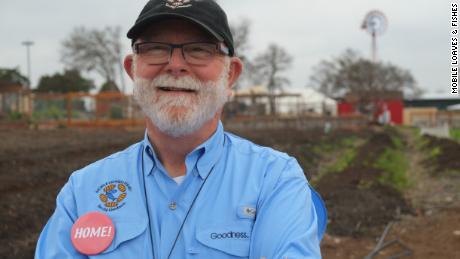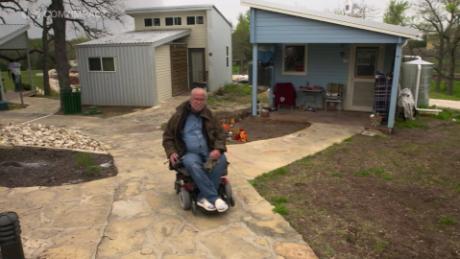It's a sight more than 200 formerly homeless people are waking up to each morning at the Community First! Village in Austin, Texas.And they can take their time getting used to it; residents are invited to stay for the rest of their lives.Community First! Village is built and run by the nonprofit Mobile Loaves & Fishes to lift the most chronically homeless off the streets and into a place they can call home.They live in about 100 RVs and 125 micro homes arranged on streets with names like "Peaceful Path" and "Goodness Way."Heavy machinery has broken ground on the neighboring 24 acres to add another 310 housing units. When complete, Mobile Loaves and Fishes believes it will be able to provide permanent homes for approximately 40% of the chronically homeless in Austin.
Building a community that cares for each other
Providing a home is not enough, according to founder Alan Graham."We believe that housing will never solve homelessness, but community will," Graham told CNN."Because within each of us innately are two fundamental human desires to be fully and wholly loved and to be fully and wholly known and just stuffing somebody into a shelter or a house with four walls and a roof is nowhere near sufficient. It's all about the relationship here." The 51-acre planned village was designed to create a sense of community. The homes are "micro" on purpose, providing just enough comfort and privacy but small enough to encourage the owners to step outside. There they find front porches dotted along stone-paved paths that lead to community kitchens, laundry and wash rooms, meeting halls, playgrounds, a dog park, a barber shop, an outdoor movie theater, a medical facility and a community market.
The 51-acre planned village was designed to create a sense of community. The homes are "micro" on purpose, providing just enough comfort and privacy but small enough to encourage the owners to step outside. There they find front porches dotted along stone-paved paths that lead to community kitchens, laundry and wash rooms, meeting halls, playgrounds, a dog park, a barber shop, an outdoor movie theater, a medical facility and a community market. "What you're seeing is a 250-bedroom, 18-million-dollar mansion," Graham explains. "And so you come out of your bedroom and down the hallway metaphorically is the media room or the kitchen. They're going to see people at the shared kitchens, the movie theater or out in front of the community market just spending time with each other. So it's really that human interaction that is so critically important. And when that happens, relationships begin to form, and that becomes the power of community."New residents might initially keep to themselves, but it is hard to resist the smell of Texas barbecue on the grill, or the sight of fresh vegetables grown on site and being sliced for the community potluck dinner. Hearing the rhythmic tunes of a jam session in Unity Hall is an open invitation to take a seat, tap a foot, and maybe even add a voice to the chorus.
"What you're seeing is a 250-bedroom, 18-million-dollar mansion," Graham explains. "And so you come out of your bedroom and down the hallway metaphorically is the media room or the kitchen. They're going to see people at the shared kitchens, the movie theater or out in front of the community market just spending time with each other. So it's really that human interaction that is so critically important. And when that happens, relationships begin to form, and that becomes the power of community."New residents might initially keep to themselves, but it is hard to resist the smell of Texas barbecue on the grill, or the sight of fresh vegetables grown on site and being sliced for the community potluck dinner. Hearing the rhythmic tunes of a jam session in Unity Hall is an open invitation to take a seat, tap a foot, and maybe even add a voice to the chorus. The village also includes an art studio, an artisan blacksmithing shop, glassblowing, beekeeping, a community garden and a car care shop. These hobbies teach new skills and become a source of dignified income."We offer a number of micro-enterprise opportunities on this property that in the past two years has distributed over one million dollars to the neighbors that live in this community," says Graham. "From the bed and breakfast, movie theater and car care business to the pottery, jewelry making, blacksmithing and organic farming operation. All of this is being done by the men and women that are here."
The village also includes an art studio, an artisan blacksmithing shop, glassblowing, beekeeping, a community garden and a car care shop. These hobbies teach new skills and become a source of dignified income."We offer a number of micro-enterprise opportunities on this property that in the past two years has distributed over one million dollars to the neighbors that live in this community," says Graham. "From the bed and breakfast, movie theater and car care business to the pottery, jewelry making, blacksmithing and organic farming operation. All of this is being done by the men and women that are here." In the heart of the village is a large community center called Unity Hall where adminiRead More – Source
In the heart of the village is a large community center called Unity Hall where adminiRead More – Source
[contf] [contfnew] 
CNN
[contfnewc] [contfnewc]





